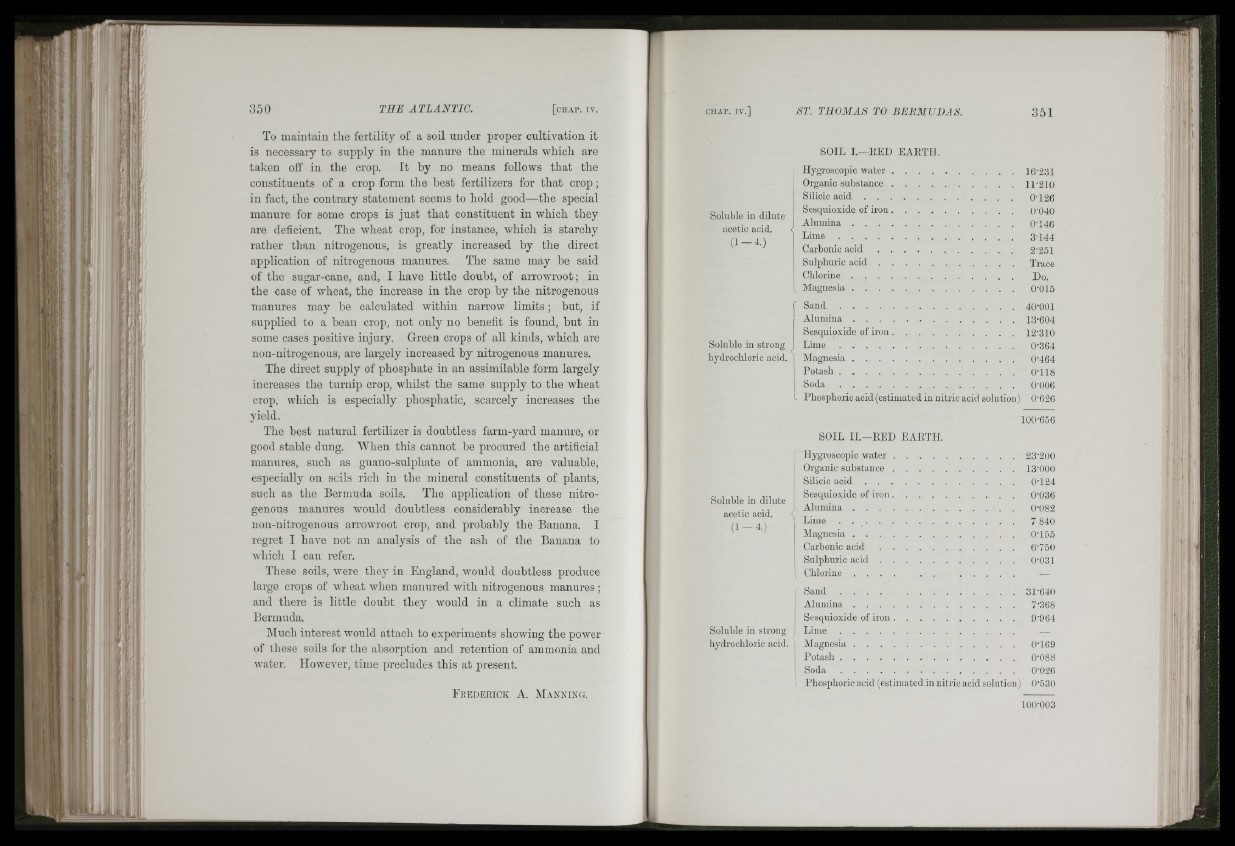
f
ff IT
350 THE ATLANTIC. [ c h a p . IV.
To maintain the fertility of a soil under proper cultivation it
is necessary to supply in the manure the minerals which are
taken off in the crop. It by no means foUows that the
constituents of a crop form the best fertilizers for that crop ;
in fact, the contrary statement seems to hold good—the special
manure for some crops is just that constituent in which they
are deficient. The wheat crop, for instance, which is starchy
rather than nitrogenous, is greatly increased by the direct
application of nitrogenous manures. The same may be said
of the sugar-cane, and, I have little douht, of arrowroot; in
the case of wheat, the increase in tlie crop hy the nitrogenous
manures may be calculated within narrow limits ; but, if
supplied to a bean crop, not only no benefit is found, but in
some cases positive injury. Green crops of all kinds, which are
uou-nitrogeuous, are largely increased by nitrogenous manures.
The direct supply of phosphate in an assimilable form largely
increases the turnip crop, whilst the same supply to the wheat
crop, which is especially phosphatic, scarcely increases the
yield.
The best natural fertilizer is doubtless farm-yard manure, or
good stable dung. When this cannot he procured the artificial
manures, such as guauo-sulphate of ammonia, are valuable,
especially on soils rich in the mineral constituents of plants,
such as the Bermuda soils. The application of these nitrogenous
manures would doubtless considerably increase the
non-nitrogenous arrowroot crop, and probably the Banana. I
regret I have not an analysis of the ash of the Banana to
which I can refer.
These soils, were they in England, would doubtless produce
large crops of wheat when manured with nitrogenous manures ;
and there is little doubt they would in a climate such as
Bermuda,
Much interest would attach to experiments showing the power
of these soils for the absorption and retention of ammonia and
water. However, time precludes this at present.
F rederick A. Manning.
CIIAP. IV.] ST. THOMAS TO BERMUDA S. 351
Soluble in dilute
noetic acid.
( 1 - 4 . )
Soluble in strong
liydrocliloric acid.
Soluble in dilute
acetic acid.
(1 -4 .)
Soluble in strong
liydrocliloric acid.
SOIL I.—KED EARTH.
Hygroscopic w a te r ....................................................... 16‘231
Organic su b stan c e .................................................. 11‘210
Silicic a c i d .....................................................................0 ’126
Sesquioxide of iron......................................................... 0'040
A lu m in a ..........................................................................0T46
L im e ................................................................................3-144
Carbonic a c i d ............................................................... 2'251
Sulphuric a c i d ...............................................................Trace
C h lo r in e ................................................................... Do.
Magnesia.......................................................................... 0'015
S a n d ........................................................................ 40-001
A lu m in a ........................................................................13’C04
Sesquioxide of iron....................................................... 12'310
L im e ............................................................................... 0-364
Magne.sia..........................................................................0'464
P o ta sh ................................................................................0-118
S o d a ............................................................................... 0-006
Phosphoric acid (estimated in nitric acid solution) 0-626
100-656
SOIL IL—RED EARTH.
Hygroscopic -water.................................................. 23-200
Organic su b stan ce....................................................... 13-000
Silicic a c i d .....................................................................0-124
Sesquioxide of iron......................................................... 0-036
A lu m in a ..........................................................................0-082
Lime . ............................................................. 7 840
Magnesia..........................................................................0-165
Carbonic a c i d ...............................................................6-750
Suliihuric a c i d ...............................................................0-Q31
Chlorine . . . . . . —
Sand . . . . ............................................ 31-640
A lu m in a .......................................................................... 7-368
Sesquioxide of iron.........................................................9-964
L im e ........................................................................ —
Magnesia..........................................................................0-169
P o ta sh ............................................................................... 0-088
S o d a ............................................ 0-026
Phosjrlioric add (estimated in nitric acid solution) 0-530
!ilJ
I t t i - I
'il
4 I-;
F r
ffi: L 1
I'
:. i: